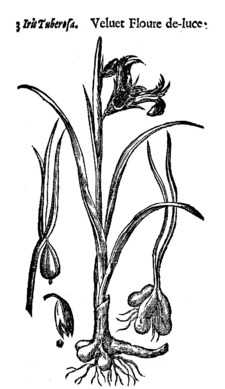
Gerard's Herbal Vol. 1
|
|
|
| Fig. 172. Spanish Nut (1) |
Fig. 173. Small Spanish Nut (2) |
The Description.
1. Spanish Nut hath small grassy leaves like those of Star of Bethlehem, or Ornithogalum among which riseth up a small stalk of half a foot high, garnished with the like leaves, but shorter. The flowers grow at the top, of a sky colour, in shape resembling the Fleur-de-lys, or common Iris; but the leaves that turn down are each of them marked with a yellowish spot: they fade quickly, and being past, there succeed small cods with seeds as small as those of Turnips. The root is round, composed of two bulbs, the one lying upon the other as those of the Corn-flag usually do and they are covered with a skin or film in shape like a net. The bulb is sweet in taste, and may be eaten before any other bulbed root.
2. There is set forth another of this kind, somewhat lesser, with flowers that smell sweeter than the former.

Fig. 174. Velvet Fleur-de-lys
3. Velvet Fleur-de-lys hath many long square leaves, spongeous or full of pith, trailing upon the ground, in shape like to the leaves of rushes: among which riseth up a spike of a foot high, bearing at the top a flower like the Fleur-de-lys. The lower leaves that turn downward are of a perfect black colour, soft and smooth as is black velvet; the blackness is welted about with greenish yellow, or as we term it a goose-turd green; of which colour the uppermost leaves do consist: which being past, there followeth a great knob or crested seed vessel of the bigness of a man's thumb, wherein is contained round white seed as big as the vetch or tare. The root consisteth of many knobby bunches like fingers.
The Place.
These bastard kinds of Fleur-de-lys are strangers in England, except it be among some few diligent herbarists in London, who have them in their gardens, where they increase exceedingly; especially the last described, which is said to grow wild about Constantinople, Morea, and Greece: from whence it hath been transported into Italy, where it hath been taken for Hermodactylus, and by same espressed or set forth in writing under the title Hermodactylus; whereas in truth it hath no semblance at all with Hermodactylus.
The Time.
The wild or bastard Fleur-de-lys do flower from May to the end of June.
The Names.
1, 2. These bulbed bastard Fleur-de-lys, which we have Englished Spanish Nuts, are called in Spain, Nozelhas; that is, little Nuts: the lesser sort are Parva Nozelha, and Macuca: we take it to be that kind of nourishing Bulb which is named of Pliny, Sisynrichium.
3. Some, as Ulysses Aldroandus, would have this to be Louchitis Prior, of Dioscorides. Matthiolus makes it Hermodactylus verus, or the true Hermodactyl: Dodonĉus and Lobel more fitly refer it to the Fleur-de-lys, and call it Iris tuberosa.
The Nature and Virtues.
Of these kinds of Fleur-de-lys there hath been little or nothing at all left in writing concerning their natures or virtues; only the Spanish nut is eaten at the tables of rich and delicious, nay vicous persons, in salads or otherwise, to procure lust and lechery.